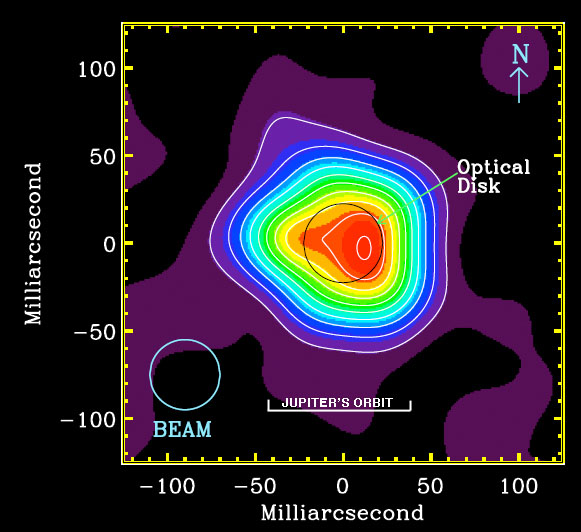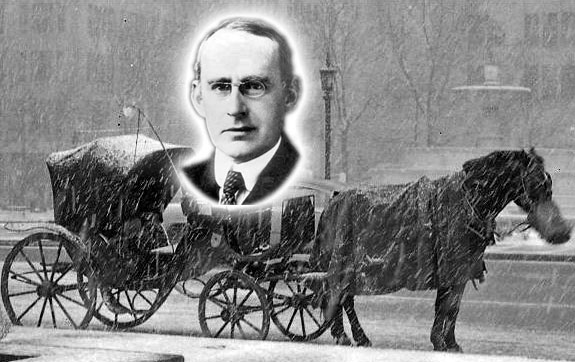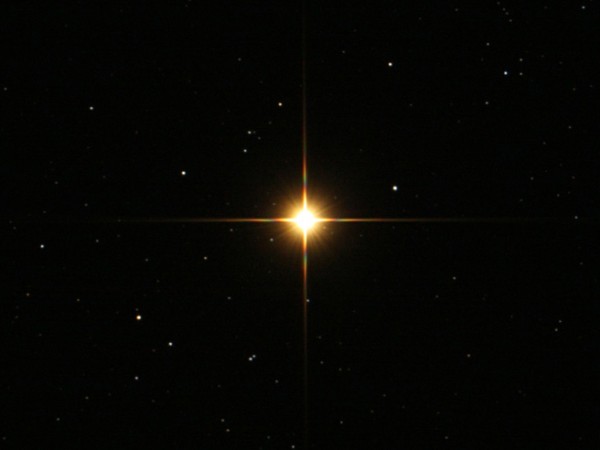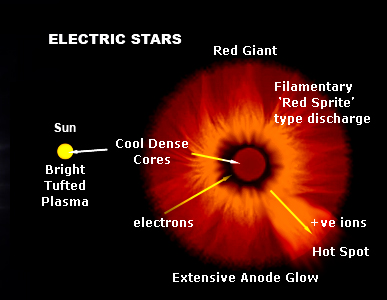holoscience.com | The ELECTRIC UNIVERSE®
A sound cosmology for the 21st century

The Mystery of the Shrinking Red Star
We cannot see what is not on our mental ‘map.’ Almost the entire visible universe is in the form of highly-conductive plasma but electrical discharge in plasma is nowhere on the map.
The red supergiant star Betelgeuse, the bright reddish star in the constellation Orion, has steadily shrunk over the past 15 years, according to researchers at the University of California, Berkeley. Betelgeuse’s radius is about five astronomical units, or five times the radius of Earth’s orbit. The average speed at which the radius of the star is shrinking over the last 15 years is approximately 470-490 miles per hour. That means the star’s radius has shrunk by a distance equal to the orbit of Venus
“We do not know why the star is shrinking, considering all that we know about galaxies and the distant universe, there are still lots of things we don’t know about stars, including what happens as red giants near the ends of their lives.”
—Edward Wishnow, UC Berkeley’s Space Sciences Laboratory.
This is the most recent admission of ignorance about stars. But it will make no difference because astrophysicists cannot see what is right in front of them. Most of their ‘mental map’ is missing. That is evident from the bold assertion about, “all that we know about galaxies and the distant universe,” most of which, when examined objectively, is knowledge that just ain’t so. Astrophysicists, using their old-fashioned map of how stars work, will not solve the mystery of the shrinking red supergiant star—Betelgeuse.
A Bit of Stellar Perspective
There is a principle which is a bar against all information, which is proof against all argument, and which cannot fail to keep man in everlasting ignorance. That principle is condemnation without investigation.
—William Paley (1743-1805).

I mean by an “old-fashioned view of how stars work,” the self-gravitating, self-consuming ball of gas with a thermonuclear heat engine inside to ‘pump it up’ to the size and brightness we observe. The notion that a star (the Sun) might be powered externally was condemned without proper investigation by the pioneer of the thermonuclear model of stars, Sir Arthur Stanley Eddington. As witness, his opening words in The Internal Constitution of the Stars (1930), “At first sight it would seem that the deep interior of the sun and stars is less accessible to scientific investigation than any other region of the universe.” But immediately Eddington assumed a principle that cannot fail to keep man in perpetual ignorance of the real nature of stars: “radiant energy from the hot interior after many deflections and transformations manages to struggle to the surface and begin its journey across space.” This assumption, if correct, would make stars the only known bodies in the universe that transfer internal heat by radiation. Normally, conduction and convection do the job. So it is not a trivial assumption backed up by observation or experiment. The idea that stars are fuelled from the inside did not come from some scientific discovery. It is an idea as old as the discovery of fire. It was introduced as a belief, as an ideological perversion of science.
Eddington had a paternalistic put-down for any of his contemporaries so rash as to suggest that a star might be powered from the outside, and he succeeded very well in squelching any further theorizing in that direction. But his reasoning was flawed by assumptions he failed to recognize as such—for example: “Given, that energy flows out from the interior of a star.”
—Ralph E. Juergens.
It is easy to see, with hindsight, that Eddington’s influence combined with his peculiar views provided a ‘mental map’ to divert and to retard progress in understanding stars for a century. The forming, by gravitational collapse, of a star with a superhot core composed of the lightest gas, hydrogen, is a remarkable ‘Heath-Robinson’ construction based on the choice of an improbable model with consequent unlikely assumptions. It fails the observational test because nothing we observe on the Sun and above the Sun is predictable from the nuclear fusion model. And surprising new discoveries have required ad hoc additions to the model, while many basic observations remain unexplained—like the superhot corona above a “cold” photosphere.
“A star like the Sun is remarkable… We have the strange phenomenon of a relatively cool body in space enveloped in an immensely hot atmosphere. (We can note in passing that the Earth’s upper atmosphere is hotter than its surface but this is less remarkable as in the Earth’s case the energy comes from without.)”
– Prof. R L F Boyd, F.R.S., Space Physics – the study of plasmas in space, Oxford Physics Series. [Emphasis added]
“Science frequently makes choices between alternatives. Once the choice is made, however, scientists tend to unify behind the accepted alternative to the extent of denying and eventually forgetting that there was any ‘real’ choice made. Subsequent textbooks gloss over any possible alternatives, depicting science as a straightforward march up the one correct path toward truth. Since it is forgotten and denied that such choices existed, the results of these choices are rarely reviewed. Not only is there no provision, or incentive, for such a review, there is positive, and powerful, peer pressure against any such questioning of basic premises.”
—Don L. Hotson.
The Electric Model of Red Stars
“Everlasting ignorance” of the real nature of stars is not an option. Plasma cosmologists have developed a simple and coherent model of galaxy and star formation using electrical energy operating in omnipresent cosmic plasma. The electric circuit model of galaxies and stars proposed by Hannes Alfvén can be extended to explain the complex magnetic fields and visible phenomena of the Sun. Only the disciplinary fragmentation of the ‘mental map’ of modern science allows astrophysicists to not see this crucial contribution to their subject. For example, astrophysicists puzzle over the ‘rocket motors’ they have found in active galactic nuclei, while across the campus plasma physicists announce their discovery of an electrically powered plasma double layer rocket motor! While as long ago as 1986, at a NASA conference on “Double Layers in Astrophysics,” Alfvén said in his keynote address, “Double layers in space should be classified as a new type of celestial object.” **
Eddington’s ideas should be regarded as a historical aberration of his gaslight era where light and heat were produced from hot gases. Compare that with our electrical world, where electrical energy generated perhaps hundreds of miles distant is used to light our cities and homes, and you can see the simple sense in proposing that Nature operates in the same manner. It makes even more sense when it is understood that plasma naturally forms invisible but detectable cosmic current filaments like our earthly power transmission lines. Stars are like galactic street lights, lighting the path traced by cosmic electrical energy flowing through the galaxy.
Low-mass electrons carry most of the electric current in space plasma. Galaxies and the stars within them seem to be “born” electron deficient by an efficient charge separation process observed in laboratory plasma discharges. Stars operate as positive anodes in a galactic glow discharge. I wrote about red giant stars in Twinkle, twinkle electric star:
Red stars are those stars that cannot satisfy their hunger for electrons from the surrounding plasma. So the star expands the surface area over which it collects electrons by growing a large plasma sheath that becomes the effective collecting area of the stellar anode in space. The growth process is self-limiting because, as the sheath expands, its electric field will grow stronger. Electrons caught up in the field are accelerated to ever-greater energies. Before long, they become energetic enough to excite neutral particles they chance to collide with, and the huge sheath takes on a uniform ‘red anode glow.’ It becomes a red giant star.
The electric field driving this process will also give rise to a massive flow of positive ions away from the star, or in more familiar words—a prodigious stellar ‘wind.’ Indeed, such mass loss is a characteristic feature of red giants. Standard stellar theory is at a loss to explain this since the star is said to be too ‘cold’ to ‘boil off’ a stellar wind. And radiation pressure is totally inadequate. So when seen in electric terms, instead of being near the end point of its life, a red giant may be a ‘child’ losing sufficient mass and charge to begin the next phase of its existence— on the main sequence.
Internal heating doesn’t cause the giant red glow of Betelgeuse. It is an electrical plasma glow like that seen in a neon tube. And like a neon or fluorescent light tube it is relatively cool. In fact, measurements of temperature (random motion) of a plasma in an electric field (directed motion) will be misleading because the electric field tends to align motions in one direction. Radio measurements of the temperature distribution in Betelgeuse’s atmosphere give readings that decrease with distance from the photosphere and are lower than those derived from the optical and ultraviolet (UV), where the temperature is calculated from theoretical model atmospheres. The radio astronomy findings could be explained by current flowing in radial filaments in the extensive, diffuse envelope of Betelgeuse, like the red sprites seen stretching up to the ionosphere above earthly thunderstorms.
Betelgeuse’s size, seen in the more energetic UV light, is double its already gigantic dimensions in visible light. The existence of high-energy UV light at large distances above the star fits an external power source like that producing the superhot solar corona. What we are seeing is the same kind of plasma sheath effect that turns insignificant rocks in our solar system into comets like the recent Comet Holmes whose glowing electrical coma exceeded the size of the Sun. The visible disk of Betelgeuse tells us nothing about the physical size of the central condensed body. And like a cometary coma’s changing size as it races toward and away from the electrified Sun, red giant stars alter their size in adjusting to their electrical environment.
The UV image of Betelgeuse is smooth apart from the occasional hotspot. This is quite distinct from the UV image of the Sun, which typically has a mottled appearance due to many active regions. This smoothness of the light from Betelgeuse is a result of the quite different mode of plasma discharge of dim red stars from that of bright main sequence stars. It is the difference between the diffuse voluminous glow of a neon tube and the pinpoint light from an arc lamp.
The electric model of bright stars shows that there is an exquisitely simple control mechanism introduced by a bright photosphere. The photosphere acts like a junction transistor to regulate the current flow between the star and its environment. It results in a remarkably steady output of light and heat radiation despite a varying power supply. For example, the Sun, viewed in X-rays, is a variable star. X-rays are generated high above the photosphere and are a measure of electrical power input. They reveal the variability of the Sun’s power source. The photosphere generates the radiant output, which is stabilized by its transistor effect.
Dim red stars like Betelgeuse do not have the same power control mechanism. They respond to variation in their power supply instead by varying the surface area of their glowing plasma sheath—in other words, their visible size. Our own Sun varies slightly in size, much to the puzzlement of astrophysicists. However, what is called “the photosphere” of Betelgeuse is physically and electrically nothing like the photosphere of bright stars.
The decrease in diameter of Betelgeuse over 15 years suggests a slow change in the power input to Betelgeuse. Shrinking is a normal response of a glow discharge plasma sheath to an increase in the availability of electrons from the galactic plasma. Such an increase may be due to rising current in the local galactic circuit. Or it may be due to a decrease in dustiness of the plasma near the star (dust particles tend to scavenge electrons). Our Sun registers such a change through the sunspot cycle and X-ray output. It seems likely that Betelgeuse will expand or oscillate in size in future. The presence of hot spots on Betelgeuse should be correlated with changes in its diameter.

From Earth, we view Betelgeuse’s pole. The radio image of Betelgeuse is not spherically or axially symmetric. This may be explained simply by the electrical model: the current flows toward the magnetic pole, which does not necessarily coincide with the rotational pole, and out in an equatorial current sheet, which may form jets that distort the atmosphere. I believe the hot spots seen on Betelgeuse are the result of bright arc discharges or ‘stellar lightning’ near the pole. Such lightning causes upwelling of matter from the star high into its atmosphere, which would explain the warm so-called “convective cells” conventionally thought to be responsible for the hot spots. Stars do not convect heat from their interiors. Photospheric granulation is a plasma ‘anode tufting’ phenomenon.
The report states that Betelguese’s visible brightness, or magnitude, has shown no significant dimming over the past 15 years despite the star’s shrinkage. This seems odd if the bloated atmosphere were due to heating from the star. However, the electrical model may offer a simple solution. As the red supergiant’s atmosphere shrinks, the anode glow remains. It is rather similar to merely shortening a neon tube. The luminous efficiency increases with the increasing particle density nearer the star, which could offset the loss of emitting surface.
The conventional model of red supergiant stars like Betelgeuse is a story of the incredibly complicated series of thermonuclear processes that progressively “burn” through the periodic table from hydrogen through helium and on up to iron. Each process is supposed to occupy a thin shell that moves outward as the star ages. But iron is the end of the line for thermonuclear transformation: When the iron core grows so massive that the atoms can no longer resist the gravitational pressure, it collapses into a superdense state, and the star explodes as a supernova. Given that Betelgeuse is the closest red supergiant, the reported shrinkage of Betelgeuse has given rise to fears in major news media about the “dying star” and the damage it might cause on Earth if it were to explode.
Such fear is misplaced. The evolutionary story of self-immolating thermonuclear stars is wrong. Betelgeuse is merely a young star that has not achieved the kind of electrical equilibrium that comes with a bright main sequence photosphere. And supernovae are galactic “electrical circuit breakers,” not a fanciful stellar implosion followed by explosion. There is, in fact, firm evidence of external triggering of supernovae, which is shown in the non-random periodic behavior of extragalactic supernovae. Plasma physicist Anthony Peratt has noted, “Supernovae in the plasma community are viewed as the release of energy from a galactic-dimensioned filament.” And the aftermath of a supernova is clearly an axial Z-pinch plasma discharge configuration.
“Astronomers can tell the temperature of the central regions of the Sun and of many other stars within a few percentage points and be quite sure about the figures they quote.”
A Star Called the Sun, —George Gamow.
“Logic is an organised system of thought that enables you to be wrong with confidence.”
—Charles Franklin Kettering.
** Pdf available online. Warning! – 6.9MB file.
Wal Thornhill

